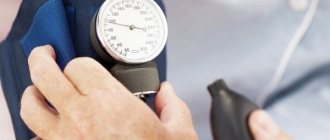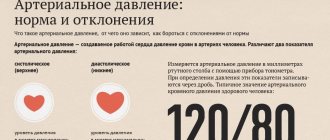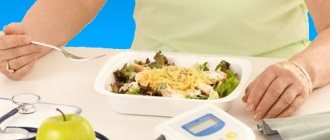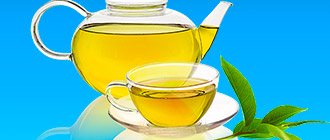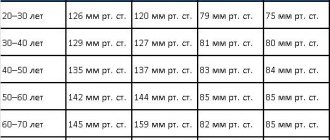- What does the tonometer reading 105 to 65 mean?
- Causes
- Associated symptoms
- Is blood pressure 105 over 65 dangerous?
- First aid for an attack
- Diagnostics and specialists
- Treatment
- Prevention measures
- Blood pressure 105 over 65 during pregnancy
- Blood pressure 105 over 65 in the elderly
- Blood pressure 105 over 65 in children and adolescents
Blood pressure is the first indicator of a person’s well-being and health status. For most people, a blood pressure of 120/80 is considered normal. But should you worry if the tonometer shows a value of 105/65? After all, there are cases when such pressure is the norm.
What does the tonometer reading 105 to 65 mean?
The vascular walls are constantly exposed to pressure from the blood passing through the blood vessels. The pumping function of the heart and the elasticity of blood vessels have a direct impact on the strength of this pressure.
The highest pressure, systolic, is recorded at the moments when cardiac contraction occurs, and the stage of the cardiac cycle itself, when pressure increases (heart contraction), is called systole.
In the intervals between heart contractions, the heart muscles relax and blood pressure decreases. This value (second digit) is called diastolic, and the corresponding stage of the cardiac cycle, when the muscles are relaxed, is called diastole.
An electronic blood pressure monitor typically displays pressure readings from top to bottom: systolic pressure will be located at the top of the display, and diastolic pressure will be at the bottom. That is, the upper number 105 is the person’s systolic pressure, and the lower 65 is the diastolic pressure.
This is an alarm bell and a reason for a person to pay more attention to their health, because a pressure of 105 over 65 is slightly lower than the reference readings of 120/80. In some cases, it indicates the beginning of some pathological processes in the body.
What is normal blood pressure?
When measuring blood pressure, we focus on the reference 120/80 mmHg. Art. However, these figures are not indicative, since for each person they depend on age, degree of physical activity, dietary habits and even the weather. What does pressure 100/80 mean and should I be afraid of developing hypotension in this case?
Before diagnosing yourself with “hypertension” or “hypotension”, you must take into account that each organism is individual. Moreover, blood pressure readings can change throughout the day. The norm also depends on age. A young man actively involved in sports has a blood pressure of 100/80 mm Hg. Art. with a pulse of 80 there should be no concern. If the pulse is 100 beats per minute, this indicates tachycardia.
With age, blood pressure begins to rise, which is associated with wear and tear of blood vessels and other changes in the body. For example, for a 60-year-old man, low blood pressure with a pulse of 85 or higher is low and indicates problems in the functioning of the cardiovascular system.
In addition to systolic and diastolic pressure indicators, the doctor pays attention to the pulse difference. If it falls within the range from 20 to 50 mm Hg. Art., this is considered normal. That is, with figures of 100/80 mm Hg. Art. It is impossible to talk about pathology without the presence of other symptoms.
Low blood pressure is considered to be a blood pressure of 90/60 mm Hg. Art. and below. If such numbers are constant, we can talk about chronic arterial hypotension. Temporary fluctuations in pressure downward are called a hypotonic state. To determine the diagnosis, it is necessary to undergo an examination, which includes daily monitoring of blood pressure and pulse rate.
Causes
Pressure 105 over 65 has a lot of prerequisites of a different nature: both physiological (caused by improper functioning of internal organs and systems, unhealthy lifestyle, etc.) and psychosomatic (caused by stress, as a result of worrying, etc.). In addition, the reasons may vary depending on the gender of the person.
Among women
For women aged 20-40 years, a pressure of 105 over 65 is quite acceptable: among the fair sex, the pressure is almost always lower than among men. This is due to the fact that there are a number of differences in the functioning of the autonomic nervous system of men and women.
Blood pressure of 105/65 in women, as a rule, does not require any special treatment, especially if the person feels well and has no complaints.
In men
For men, especially those in good physical shape, a blood pressure of 105/65 is not typical. There are a number of reasons leading to low blood pressure in the stronger sex (sometimes these reasons are also relevant for women):
- lack of vitamins C, E, group B;
- exhaustion;
- stress, chronic fatigue, depression;
- weather dependence - weather changes and prolonged exposure to the sun;
- anemia;
- endocrine system disorders;
- vegetative-vascular dystonia;
- osteochondrosis of the cervical spine;
- infectious diseases;
- tuberculosis;
- stomach ulcer;
- hereditary predisposition;
- side effects of medications.
Associated symptoms
Hypotension (low blood pressure) is characterized by the following symptoms:
- chronic fatigue and lethargy;
- fainting;
- fast fatiguability;
- constant drowsiness;
- darkening of the eyes, especially during sudden ascents;
- irritability;
- sound and photophobia;
- excessive heartbeat even with light exertion;
- memory impairment;
- problems with concentration;
- cold hands and feet;
- deterioration of libido;
- muscle weakness;
- indigestion;
- intolerance to heat and/or cold;
- regular headaches and/or dizziness;
- low body temperature;
- seasickness.
If a person experiences at least three of the listed symptoms on an ongoing basis without any factors directly causing such symptoms, it is strongly recommended to consult a specialist.
Recommendations
If the cause of arterial hypertension is any concomitant disease, the necessary set of measures is selected, including the use of medications and surgical interventions (if necessary). Nutritional correction is required. You must also follow the recommendations described below.
Every day you should do twenty minutes of gymnastics; daily walking shows good results. You can use a contrast shower; after a shower, it is useful to rub the skin with a towel until redness appears (in the absence of hypertension). Specialists can prescribe general, lymphatic drainage, and hardware massage.
Drinking caffeinated drinks should not increase your blood pressure. The maximum is two cups of coffee or tea per day. If this concerns pregnant women, it is better to add milk to coffee without overusing the quantity and strength of the drink. The same recommendations apply to elderly patients. Nutrition should be balanced, rich in essential vitamins and minerals. To normalize vascular tone, you can use decoctions of ginseng, golden root or elecampane. A good night's sleep is also important.
Is blood pressure 105 over 65 dangerous?
Before judging whether a blood pressure of 105/65 is dangerous, it is necessary to identify the type of phenomenon:
- Primary hypotension is typical for weather-dependent people, as well as people who lead a sedentary lifestyle, are exposed to constant stress and are regularly in nervous tension. Primary hypotension is characterized by normal human performance and activity in the first half of the day and a rapid reduction in vitality in the second half. This type of pressure 105 to 65 is uncritical and harmless. It only negatively affects your overall well-being.
- Secondary – a concomitant symptom of blood loss, chronic infectious and other diseases. Characteristic of immobility, malnutrition and lack of vitamins. In this case, the danger is not the pressure indicator itself, but the cause of hypotension that requires treatment.
- Normal for humans. This type is possible, and, moreover, very common, especially among teenagers and young women. In this case, a pressure of 105 over 65 does not require treatment, especially in conditions where the person has no complaints related to concomitant symptoms.
- Temporary phenomenon. Blood pressure is influenced by many factors, so its short-term and isolated decrease is not a reason for concern, for example, if a person has been in the sun for too long, his blood pressure is guaranteed to drop. The main thing is to ensure that the pressure of 105/65 does not become stable.
Thus, a pressure of 105 to 65 in itself is not dangerous and does not directly harm a person. Often, it only brings discomfort in the form of weakness, fatigue, etc. But hypotension can be a signal that something is wrong in the body, especially if the accompanying symptoms listed above are present.
Symptoms that require calling an ambulance or seeing a doctor
The manifestations are caused not only by the decrease in pulse pressure itself, but also by the underlying pathological process.
As a rule, these are cardiac signs; others are also present when the excretory system or cerebral structures are affected.
Sample list:
- Blood pressure 100/80 and headache. They go hand in hand. They mean disruption of the functioning of nerve tissues and blood circulation at the local level. The nature of the discomfort is pressing, shooting or squeezing. Occurs spontaneously, in attacks. The duration of each such episode is from several minutes to a couple of hours, rarely more. There can be many in a day.
- Feeling of discomfort in the chest. The heart turns over, ready to jump out even with a normal rhythm. These are signs of organ dysfunction. What type - you need to look at the ECG. In any case, this is a worrying sign.
- Vertigo or dizziness. From a slight feeling of fog, movement of space in a circle to the inability to navigate even in your own room. Caused by tissue hypoxia, in particular the cerebellum.
- Dyspnea. In a state of complete rest. Develops against the background of tachycardia or other arrhythmias. Accompanied by dissatisfaction with the process. As a result of gas exchange disturbances, a drop in blood saturation is observed.
- Cyanosis of the nasolabial triangle. Blue discoloration of the area around the mouth. Appears as a result of disturbances in the functioning of cardiac structures.
- Paleness of the skin.
- Nausea, vomiting. Repeated, not bringing relief.
- Fainting. This is a dangerous sign and indicates a significant malnutrition of the brain. Syncope can occur repeatedly throughout the day. The logical end is a massive ischemic stroke.
Low pulse pressure may not be accompanied by symptoms at all. This does not mean that the process is difficult or easy. It’s just a feature of the patient’s body.
The signs described above require a scheduled visit to the doctor.
First aid for an attack
In any case, a decrease in pressure, especially if for a particular person 105/65 is not the norm, brings discomfort. And there are a number of methods that are great for helping to raise blood pressure. The effect is short-term, but unconditional:
- Coffee. It is not for nothing that it is strictly prohibited for hypertensive patients, because caffeine is a substance that directly increases blood pressure. Strong black tea can also be a great alternative.
- Playing sports. Short-term but intense exercise is guaranteed to raise blood pressure, since physical activity directly affects the functioning of the heart and blood vessels responsible for blood pressure.
- Shower. A contrast shower quickly and effectively tones the entire body, affecting the circulatory system.
- Essential oils. Essential oils can help raise blood pressure temporarily. Citrus, pine and spicy aromas are excellent helpers, but it is better to avoid calming ones (for example, chamomile, mint, lavender).
- Food. Nuts, fruits and dried fruits, cheese and chocolate are an effective and tasty way to raise your blood pressure a little.
Correction of indicators and first aid
To increase the pressure, you must follow the following algorithm:
- Call a team of medical workers.
- Lie on a horizontal surface with the leg end raised or lay the victim down in this way.
- Open a window or direct a fan to provide fresh air.
- Drink sweet warm tea or give the victim something to drink. You can add 10 drops of tincture of eleutherococcus, ginseng or Rhodiola rosea.
- Rub your whiskey with lemon essential oil.
Diagnostics and specialists
If hypotension is regular and associated symptoms are present, it’s time to consult a specialist. In this case, you should go to a therapist.
To make a diagnosis, the therapist will need to study the life and family history, listen to the patient’s complaints, and also pay attention to the reasons and circumstances in which the symptoms accompanying hypotension arose. In case of ambiguous indications, the therapist may prescribe the following series of diagnostic procedures:
- blood and/or urine test;
- Ultrasound examinations (ultrasound) of the chest and abdominal organs;
- computed tomography (CT);
- magnetic resonance imaging (MRI);
- radiography;
- electrocardiography;
- echocardiography, etc.
Serial tonometry results are the main diagnostic indicator, demonstrating fluctuations in blood pressure at different times of the day and in different situations.
Symptoms of hypotension and the danger of the condition
Patients seek medical help with the following complaints:
- the appearance of drowsiness and loss of strength;
- cephalgia;
- general weakness;
- dizziness;
- decreased performance;
- discomfort in the heart area;
- nausea, sometimes vomiting.
A headache with hypotension differs from the one that occurs against the background of elevated blood pressure numbers, which allows you to differentiate your own condition if you don’t have a tonometer at hand. With hypertension, the pain seems to compress the head, and pulsation occurs in the temples and crown. Against the background of hypotension, the pain is aching in nature and often appears in the back of the head. The danger of hypotension lies in the fact that blood flow slows down, that is, the brain and internal organs do not receive the required amount of blood, and therefore nutrients and oxygen.
Treatment
If a blood pressure of 105 over 65 is not normal for a given person, treatment is indicated (which should be prescribed by a specialist). There are four areas of therapy: drugs, nutrition, physical activity and, as an auxiliary method, traditional medicine.
Drug therapy
Caffeine is a time-tested substance that increases blood pressure. As a rule, therapists do not prescribe caffeine itself separately, but rather prescribe tablets (and other medicinal forms) that contain it, for example, Askofen, Citramon, etc.
However, not only caffeine helps with hypotension. Below is a list of drugs that are most often prescribed by specialists for a blood pressure of 105 over 65:
- Citramon. The drug not only increases blood pressure, but also has anti-inflammatory, antipyretic and analgesic effects.
- Ortho Taurine. Reduces calcium overload, removes excess fluid from the body, has a calming effect on the nervous system, and relaxes blood vessels.
- Regulton. Prescribed in connection with hypotension with accompanying symptoms of fear, anxiety, insomnia, dizziness, mental overload.
- Saparal. The drug helps people with hypotension complicated by depression and neurasthenia. It is also used as a prophylactic for mental and physical fatigue.
- Glycine. The drug is a neurotransmitter that improves metabolic processes in brain tissue, which leads to stabilization of the nervous system. As a result, the patient’s sleep normalizes, symptoms of depression are relieved, and irritability decreases. Prescribed to patients with psychosomatic causes of hypotension.
Nutrition
Nutrition is an important aspect of human life that significantly affects blood pressure. For example, a lack of vitamins B, C and E is often the cause of a blood pressure of 105 over 65. Therefore, your daily diet must be composed in such a way that foods containing vitamins are included in it.
The following food groups are rich in B vitamins:
- yeast (brewer's and baker's) and bran (rice and wheat);
- whole grains and wheat germ;
- cabbage and spinach;
- offal (kidneys, liver), egg yolk, chicken meat;
- tuna, salmon, sardine;
- peanuts, walnuts;
- broccoli, lentils.
Iron is also a very necessary trace element for the treatment and prevention of hypotension. A lot of iron is found in:
- dried fruits;
- beets, carrots;
- calf liver;
- beans, greens.
Strong blood vessels require essential oils, which are found in abundance in citrus fruits.
Salt is one of the food additives that naturally increases blood pressure. However, you shouldn’t overuse it either: a piece of cheese for breakfast and moderately salted food throughout the day can maintain the salt content in the body at an optimal level.
A cup of coffee in the morning and tea throughout the day can keep the body and blood vessels in good shape.
But everything is good in moderation. If a person’s blood pressure is 105/65, this does not mean that he needs to drink liters of coffee every day, or that his diet should consist only of the listed products.
And, of course, water. People with hypotension should drink more than the reference 1.5-2 liters of water per day.
The following video describes products that can increase blood pressure:
Physical activity
For people with a blood pressure of 105/65, long, exhausting “endurance” exercises are not recommended. On the contrary, short-term but intense exercise will be most welcome, for example, cardio exercise, speed running, etc.
However, when performing exercises, you should first of all listen to your own feelings: at the slightest signs of weakness, darkening in the eyes, dizziness, etc., physical activity should be stopped immediately.
Folk remedies
Medicinal herbs are indispensable assistants in traditional medicine for low blood pressure. Various tinctures, mixtures, drinks and herbal teas are an excellent auxiliary remedy, both in combination with drugs for secondary hypotension, and as a separate remedy for primary and temporary hypotension.
Extract of Eleutherococcus senticosus, tincture of common ginseng, Sterculia platanofolia, Leuzea safflower, Aralia Manchuriana are excellent in helping to normalize blood pressure, including hypotension. You can buy them at any pharmacy, and you need to take them before meals in the following concentrations in half a glass of water:
- Eleutherococcus senticosus extract – 2 milliliters;
- tincture of ordinary ginseng - from 20 to 40 drops;
- tincture of Sterculia planatafolia and Manchurian aralia - from 15 to 20 drops;
- Leuzea safflower extract – about 25 drops.
If a person does not tolerate infusions with alcohol, you can add the tincture to water and wait 20 minutes, after which the alcohol will evaporate and the tincture will not cause damage to the gastric mucosa.
Medicinal preparations are taken in courses of 2-4 weeks, after which a break of 1.5-2 weeks is required. In the future, if desired, the course can be repeated, but this time halved.
The first herbal recipe for hypotension:
- peppermint – 30 g;
- Manchurian aralia roots – 30 g;
- roots of Eleutherococcus senticosus – 25 g;
- Schisandra chinensis fruits – 15 g;
- May lily of the valley – 10 g.
Preparation. 1 tablespoon of herbal mixture is poured into a glass of boiled water and infused for 20 minutes.
Application. You need to consume a third of a glass twice a day, half an hour before meals.
Second recipe:
- Astragalus wooliflora – 20 g;
- Panax ginseng root – 20 g;
- hawthorn fruits – 20 g;
- chamomile flowers – 15 g;
- peppermint – 15 g;
- ephedra horsetail (upper part of the plant) – 10 g.
Preparation. 1 tablespoon of herbal mixture is poured into a glass of boiled water and infused for 20 minutes.
Application. The collection is taken three times a day - a third of a glass immediately after meals.
Third recipe:
- Schisandra chinensis fruits – 30 g;
- hawthorn fruits – 20 g;
- knotweed - 15 g;
- rhizomes of Leuzea safflower - 15 g;
- May lily of the valley – 10 g;
- chamomile flowers – 10 g.
Preparation. 1 tablespoon of herbal mixture is poured into a glass of boiled water and infused for 20 minutes.
Application. Twice a day, a third of a glass half an hour before meals.
Vitamin drinks are not inferior to tinctures and herbal preparations in terms of effectiveness. They are prepared and used in the same way as herbal preparations.
First recipe for a vitamin drink:
- St. John's wort - 10 g;
- hawthorn fruits – 15 g;
- stinging nettle – 15 g;
- rose hips – 20 g;
- Rhodiola rosea root – 20 g;
- high zamanikha roots – 20 g.
Second recipe:
- Calendula officinalis flowers – 10 g;
- large plantain leaves – 10 g;
- red rowan fruits – 10 g;
- St. John's wort - 10 g;
- rhizomes of Leuzea safflower - 15 g;
- Manchurian aralia roots – 15 g;
- hawthorn fruits – 15 g.
Do not forget about the proven folk remedy - Chinese lemongrass . A variety of health drinks can be prepared from its fruits: syrup, juice, jelly, fruit juice and tea. The plant has a tonic effect, invaluable for blood pressure of 105 to 65.
Chinese lemongrass juice recipe:
- fresh berries are thoroughly washed under running water;
- after this, juice is squeezed out of the berries (manually or using a juicer);
- the resulting juice is poured into sterilized half-liter jars;
- jars with juice are re-sterilized for 10-15 minutes and sealed.
This juice is added to tea, 1 teaspoon per glass and consumed twice a day. In addition, it can be used instead of citric acid.
Chinese lemongrass syrup recipe:
- granulated sugar is added to the resulting Chinese lemongrass juice (according to the method above) in the ratio of 1 liter of juice per 2 kilograms of granulated sugar;
- the dishes with the mixture are placed on low heat until the sand is completely dissolved;
- the resulting syrup is poured into sterilized dark glass jars.
The syrup, like juice, can be added to other drinks, and can be stored for up to three years in a cool, dark place.
Prevention measures
For good health and normal blood pressure, you should adhere to the following preventive rules:
- Get enough sleep. Experts strongly do not recommend sleeping less than 6 hours a day, and the optimal duration of daily sleep is 8 hours. It is also recommended to spend some time in bed after the signal to get up: stretch, warm up, do a short warm-up while lying down.
- Proper and regular nutrition. Avoid diets, but stick to a proper diet with optimal protein, fat and carbohydrate content. It's better to eat more often, but less.
- Vitamins. It is important not only to eat a variety of foods and do it on time, but also to ensure that the menu contains a sufficient amount of vitamins. If difficulties arise with this, it is recommended to take multivitamins in courses according to the recommendations of the therapist or the instructions of each specific manufacturer.
- Daily walks. Walking in the fresh air not only saturates the human body with oxygen and vitamin D, but also provides healthy physical activity.
- Hardening. Hardening not only improves immunity, but also strengthens blood vessels, which is extremely important when the pressure is 105/65, which is not normal for a particular person.
- Exercise stress. Preference should be given to short, but moderately intense exercise, after which a person will not feel like after a marathon. For example, active morning exercise for twenty minutes is an excellent choice.
- Correct mode of operation. For people with a blood pressure of 105 over 65, it makes sense to choose jobs with a schedule that does not involve staying at work in the evening and on night shifts. It's best to work early in the morning. This is important due to the fact that the strength of hypotensive people runs out quite quickly, and after the lunch break they may notice their decline.
- Rest. You shouldn’t get too involved in physical exercise and the work process: rest is no less important. A hot bath, aromatherapy, relaxing massage are great helpers with this.
Blood pressure 105 over 65 during pregnancy
Pregnant women regularly experience disturbances in vascular tone, which often leads to disruption of vascular function and, as a consequence, changes in constant blood pressure. This phenomenon occurs in approximately 12% of pregnant girls and women aged twenty to forty years.
But not for everyone this is a problem or a disease requiring treatment. Most pregnant women with a pressure of 105 over 65 feel well, are able to do work for a long time and efficiently and do not complain about anything. However, it is possible that the expectant mother feels sick and may have difficulty performing actions that previously did not require much effort.
Hypotension during pregnancy can be either a symptom of a more serious disease (infectious disease, allergic condition, renal failure, thyroid problems, etc.), or an independent disease.
In any case, the expectant mother is recommended to consult about blood pressure with her gynecologist leading the pregnancy, who can determine whether there is cause for concern.
Possible complications
Outside of therapy or with an insufficiently high-quality regimen, the following consequences may occur:
- Heart failure. As a result of a drop in output, blood stagnation and a decrease in myocardial contractility.
- Stroke. Acute malnutrition of cerebral structures. Potentially fatal condition.
- Heart attack. Necrosis of the muscle layer. Leads to deficiency, dysfunction and lifelong disability. The possibility of death always looms on the horizon.
- Cardiogenic shock. Carries the greatest danger. Even with timely assistance, no one guarantees the patient’s life. Statistics show that death occurs within 3-4 years, which happens less in almost 100% of people. The cause is a repeated episode of cardiac arrest or massive heart attack.
- Vascular dementia. As a result of constant disruption of nutrition of cerebral structures. Forms a clinical picture similar to that of Alzheimer's disease.
The general decrease in quality of life is a “bonus”. All conditions are associated with premature death.
Preventing such an outcome is one of the goals of treatment. It is solved in parallel with etiotropic and symptomatic effects.
Blood pressure 105 over 65 in the elderly
Unlike high blood pressure, blood pressure of 105/65 is not considered normal for an elderly person. As a rule, even those people who suffered from hypotension in youth and adulthood notice an increase in tonometer readings with age. There are a number of reasons leading to a pressure of 105 over 65 in an elderly person, physiological and pathological.
Physiological reasons include :
- Chronic hypotension. Low blood pressure from an early age, which accompanies an older person throughout his life.
- Orthostatic hypotension. A sharp decrease in pressure resulting from a sudden change in body position.
List of pathological causes :
- Drugs. Some medications have a lowering of blood pressure as a side effect.
- Recumbent lifestyle. Staying in bed for too long (for example, due to illness) can lead to hypotension in old age.
- Blood loss. Blood loss (for example, due to internal bleeding or surgery) has a huge impact on blood pressure.
In any case, if an elderly person is found to have low blood pressure, in particular 105 over 65, you should immediately contact a specialist.
Blood pressure 105 over 65 in children and adolescents
Children and adolescents are characterized by low blood pressure relative to the standard “adult” indicators of 120 to 80. If a young growing body is comfortable with this pressure and there are no accompanying symptoms, it means that this is normal pressure for a particular young person.
However, in cases where a child notices at least a couple of symptoms of hypotension (often lethargy, headaches, fatigue), then it is definitely worth contacting your treating pediatrician.
A blood pressure of 105 over 65 is generally at the lower limit of normal. For women and children, this pressure is very common and normal. The main criterion by which it is worth assessing whether such pressure is normal is the self-perception of each individual person.
Forecast
Determined by the underlying disease. 100 to 80 and even a drop in pulse pressure is not an indicator. The problem lies deeper. Negative consequences are associated with the following factors:
- Senile age.
- Cardiac abnormalities of a pronounced kind, organic defects, congenital and acquired defects.
- Pathologies of the excretory system.
- Bad habits.
- Negative family history.
- Severe general anamnesis.
- Poor response to treatment or complete lack thereof.
It is possible to say anything concrete after a long period of observation. The more diseases, the worse the outcome. The severity of the condition is also taken into account.
